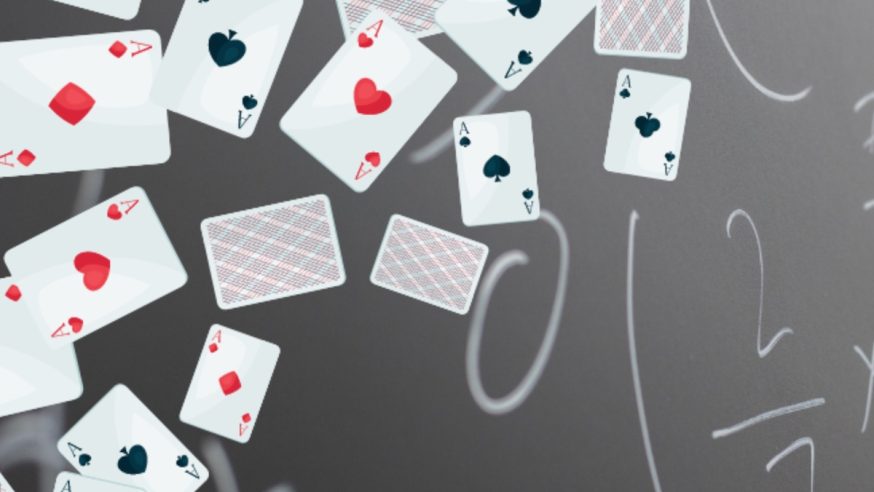When you’ve won six WSOP bracelets, countless millions and are the reigning PokerGO Tour Championship winner, what else is there…
Read MorePoker Math Essentials: From Pot Odds to Expected Value Calculations

The good thing for you is that if you do, then you’re going to make money from those who don’t.
Poker isn’t all about staring down your opponent and reading their ‘pokerface’, nor is it based on pulling off crazy all-in bluffs lifted from a movie script. The truth is that poker math fundamentals are what make a successful player. Unless you master the basics of them, you’ll forever be donating to the pot and giving away your stack in the long run.
We have discussed the fundamentals of poker math but today we will go into a bit more depth of some specific concepts. In this article, we’ll help you get acquainted with concepts like pot odds, counting your outs, hand equity, and expected value, giving you and instant edge on so many other players.
It won’t be packed with technical jargon; we’ll walk you through real-life examples and apply simple concepts to relatable hands you might play down your local bar or casino – or even online poker – this week.
The Essentials of Poker Math
Mathematics, or math, needn’t be nearly as scary as it was during your schooldays. There’s no need for a set square, equilateral triangles and we don’t go near anyone called Pythagoras. Poker math isn’t about memorizing a thousand equations for a test, nor is it about replicating here complicated work done by poker solvers like Pio Solver. It’s about understanding fundamental concepts that can pay off in real life.
You shouldn’t need an array of spreadsheets to play poker, but poker ‘cheat sheets’ can be useful things to have to hand. Just like knowing your push-fold ranges can be an advantage when short-stacked in an online poker tournament, understanding simple math shortcuts can be the difference between profit and loss.
Knowing poker math gives you confidence at the felt. You don’t have to guess if your call is good any more, you can simply check the numbers. This knowledge also has the added benefit of keeping tilt in check, meaning less frustration and a reliance not on gut instincts but math-based strategic decisions.
Poker math can’t guarantee that win on the day, but it can assure you that you will play better poker forever.
Counting Your Outs
We’ll start with one of the simplest things to calculate – how many outs you have. Out are cards that you need to arrive on later streets of the board to improve your hand to a point where it’s superior to your opponent’s cards. These ‘outs’, or unseen cards, are what can complete your hand, and you might be all-in on the flop or turn and chasing these outs.
As an example, imagine that you’re holding A♥ K♥, and the board is Q♥ 7♥ 2♣ 9♦.
Right now, you’ve got just ace-high. But your hand could improve dramatically. So how many outs do you have? Let’s presume that your opponent has queen-jack offsuit without a heart. Any ace or king win it for you – that’s six cards. Any of the remaining nine hearts would give you the flush. So six added to nine are 15 outs.
You can add these outs up manually every time you are in this situation, but as a general guide, here are the outs you’ll regularly be chasing:
- Flush draw – Nine outs.
- Open-ended straight draw – eight outs.
- Gutshot straight draw – four outs.
- Two overcards – six outs.
The Rule of Two and Four
If those numbers aren’t too complicated for you, then consider the ‘loose math’ that will allow you to work out your chances of hitting those outs. As a general rule of thumb, here’s how you work out what your chances are of hitting your outs with two cards to come from the flop or one card to come from the turn.
If you have nine outs – you’re chasing those flush cards, for example, then from the flop, you have nine outs multiplied by four. That’s 36%. If you’re hunting those nine outs from the turn to the river, then you only multiply the nine outs by two, giving you 18%. Those alternate odds are loose, so they’re imprecise. But they ‘guesstimate’ the percentage chance of you hitting your outs by the last card with the money being committed beforehand.
Understanding Pot Odds – Risk vs. Reward
Once you know your outs and have applied the Rule of Two and Four, you’re ready to connect the probability of hitting a hand to the money that is already in the pot. That’s called ‘Pot Odds’. By looking at pot odds, you can compare how much it costs to call against how much you stand to win in the hand.
Here’s the simple formula that you need to apply to the hand to calculate your pot odds.
Pot odds (%) = (Amount to Call ÷ Total Pot after Call) × 100
As an example, if there’s $100 in the pot and the villain in the hand bets $50, the pot is now $150, and you have to call a bet of $50. If you call, the total pot will be $200, so the pot odds are $50 ÷ $200, which is 25%. All of that means that you require a minimum of 25% chance of winning for your call to break even over time.
Implied Odds and Applying the Call
We’ll stick with the original hand. So you’re back holding A♥ K♥ on the board of Q♥ 7♥ 2♣ 9♦. This time, however, let’s imagine you’re up against your opponent’s two-pair hand of queen-seven. Your flush draw of nine outs with one card to come means that you have a roughly 18% chance applying the Rule of Two.
With a pot of $200, your opponent bets $50. If you call, the total pot will be worth $250. The pot odds are therefore $50 ÷ $250, which equals 20%. Your odds of hitting are 18% which is lower than the implied odds of 20% meaning that while it is marginal, over time, the hand is a fold. It might be tempting, it will even win 18% of the time, but over time, when put against the implied odds of the hand, you’re losing money. Plenty of players will put the call in here because ‘it’s not many more chips’. This is flawed logic and it costs money over time.
Expected Value – The Big Picture
Expected value (EV) is poker’s way of telling you if a play makes money in the long run. It looks at every possible outcome, weights it by probability, and gives you the average result. Once again, expected value has a relatively simple formula. This is:
EV = (Probability of Winning × Amount Won) – (Probability of Losing × Amount Lost)
In the example of the previous hand, where our chances of winning the pot are 18% and our chances of losing are therefore 82%, by calling and winning, we would make $250 (your $50 back + $200 profit), the total value of the pot. By calling and losing, we would lose just $50, because there is already $200 in the pot. Applying our EV formula, here is what happens:
EV = (0.18 × 250) – (0.82 × 50) = 45 – 41= +$4
So, you’ll make $4, right? Well, yes but while some EV calculations indicate a slight positive, the formula for implied odds includes what you’ll make over time from your opponent, so the call may not actually be worth making, especially in the long term. You will make more money from looser players over time as they keep coming back for more punishment. Tighter players are a worse bet over time, so including these considerations, it’s likely a lay-down.
Some Common Mistakes with Poker Math
Using poker math to make strong decisions is paramount. However, many players can misinterpret them if they aren’t practicing them the correct way. To this end, there are vital things to remember:
- If the pot odds are higher than your chance of hitting, you need to fold, not call.
- If some of your flush outs would complete an opponent’s full house, that would beat a flush, so those outs ned to be removed from your calculation.
- Don’t chase too many draws. If you constantly rely on drawing to hands, even if you are correct in terms of implied odds and expected value, players can pick up on that tendency not to have ‘made’ or completed hands when committing chips.
- Sometimes your outs are someone else’s. Imagine you’re chasing a flush with nine-six of hearts. Your opponent could easily have two hearts themselves with a higher collected value (such as ten-deuce or jack-four).
- The biggest mistake is getting lazy and forgetting to practice poker math, getting drawn into the game emotionally rather than applying logic and math.
In Conclusion
When considering poker math, it’s not about turning you into a robot. It is about providing you with a baseline for knowledge that allows you to make mathematically smarter decisions at the poker felt. Studying the basics on pot odds, counting outs, and expected value gives you the chance to slow down the game of poker in your mind. Your decisions should feel less chaotic, and you can process information better. As a shortcut to poker math itself, here are five quick progressive tips to incorporate into your poker game:
- Count the outs you need to win hands
- Estimate your chances of success with the Rule of Two and Four
- Compare your chances to pot odds
- Consider implied odds
- Use expected value to see the bigger picture behind every decision
If you use these tips and work on the basic poker math behind them, you’ll be playing with an automatic edge over most players you meet at the felt.
